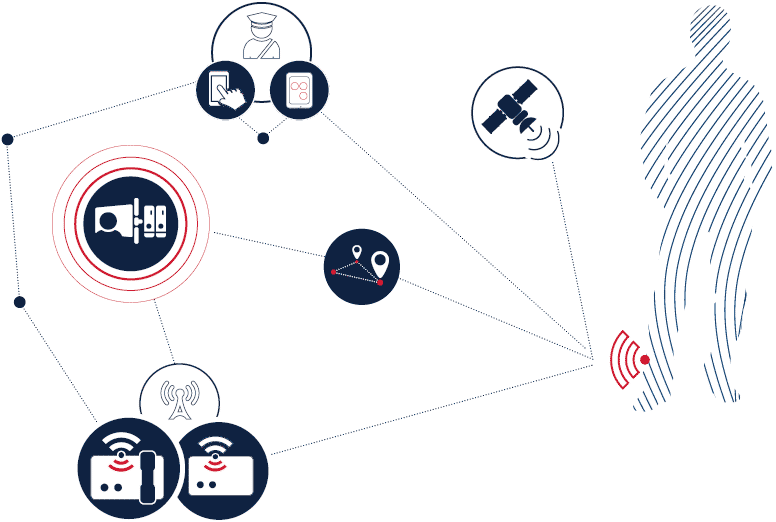
Polish
engineering solutions
engineering solutions
How does Electronic Monitoring System work?
The system is based on the correlation of electronic devices and specialized software using secure encrypted communication.
The most important elements of the system are:
The most important elements of the system are:
Transmitter (RFT)
- an electronic bracelet permanently attached to the curfewee’s ankle
- transmits a signal to the monitoring unit
- confirms the presence of a curfewee in a designated place
Stationary recorder (HU)
- installed in a place of serving a sentence
- registers signals from a curfewee’s electronic bracelet and transmits them to the Monitoring Centre
- allows to maintain a telephone contact with a curfewee and transmission of text messages
Monitoring Centre
- managed by an authorized supervising entity
- ensures continuous, unobtrusive supervision over a curfewee
- registers all the signals from the monitoring unit and maintains contact with a curfewee
Mechanism of operation

Equipment
RADIO FREQUENTY TAG (RFT) –The RFT is the basic element of offender’s equipment. It uses radio frequency technology to communicate with home units, repeaters and field officer’s equipment.
The RFT periodically communicates with the Home Units/Repeaters to let them know the subject is within the configured monitoring zone. It also transmits the status of internal sensors (strap, housing, battery level). All messages sent over radio are cryptographically authenticated
to prevent forgery and replay attacks. The RF connection is bidirectional: HUs, RPTs, TPTs and FAUs actively communicate with RFTs to synchronize time, manage tamper flags and perform security checks. These cryptographic
checks ensure that the RFT is genuine and the RF messages are not being relayed by an unauthorized device.
HOME UNIT (HU) – The HU works together with the RFT to provide RF-based curfew enforcement. Apart from communicating with nearby RFTs, RPTs and FAUs, it also has a GSM (mobile data) or PSTN (landline) link to the Central System. HUs are equipped with wide range of technical measures to protect their integrity. Attempts to open the housing, tilt or move the unit, cuts its power supply and other tampers will be detected and immediately reported to the CCS. HUs record events reported by other RF hardware (i.e. strap tampers for RFTs, movement for RPTs) and sends them to the CCS. If the data connection is not immediately available, HUs will store the events in internal memory and report them as soon as the data connection is
restored. The HU has enough memory to store hundreds of thousands of events.
ONE PART TRACKET (OPT) – The OPT is a GPS device attached to the ankle, which allows for controlling the convicted person at a specific time and place while they are serving the sentence. The OPTU as the bigger version of RFT uses the same straps. If the OPT device is tampered in any way, it sends an alarm signal directly to the monitoring centre. An OPT periodically communicates with the Monitoring Centre to let them know the
subject is in or out the configured monitoring zone. It also transmits the status of internal sensors (strap, housing, battery level). All messages sent over GSM network are cryptographically authenticated to prevent forgery and replay attacks.
DIAGNOSTIC AND INSTALLATION DEVICE (FAU) – a tool for the field operative,
allowing both monitoring device activation/deactivation and servicing. It works with an Android-based smartphone on which
the mobile application is installed (TMB), presenting the necessary information on all electronic monitoring system devices within the
range of the FAU.
TWO PART TRACKER (TPT) – The TPT device is used to monitor offenders and it works together with a RFT which is attached to the object’s ankle. The TPT operates in similar way as the HU monitoring unit. The offender is free to move within the configured zone, but an alarm is raised if he leaves the premises
without the tracking unit. If the offender does not carry the tracker with him, an alarm is raised at the monitoring centre. TPT reports its GPS location to the monitoring centre at regular intervals, accurately tracking the offender’s position. Alarms are automatically raised in the monitoring
centre software if the offender breaks his curfew conditions by entering a forbidden zone or leaving a permitted zone. The TPTs integrated mobile phone always enables monitoring staff to contact the offender.
The TPT can be also used for victim protection. This light and compact device secures the victim of violence by preventing the aggressor to approach him/her.
Software:
Communication module
a communication server enabling encrypted communication with monitoring
devices in the field.
Operator’s application
a technologically advanced application for employees of the TAO Monitoring
Centre is used to handle incidents related to convicts.
Application module
analyzing, processing and comparing received information. On the basis of
analyzes, alarms and notifications are sent to system users.
AVISPON module
It is used to
task, clear account and communicate with field teams.
Authentication module
To ensure secure user access to the application, an authentication and authorisation module is used.
Authentication is possible by means of: login and password, cryptographic cards and PKI, hardware token, two-component APTO authentication method.
Solution supplier
Enigma SOI is a Polish manufacturer, supplier and integrator of advanced IT system security
solutions of strategic importance for the security of the state, institution and citizen.
For 25 years we have been offering complete, reliable and proven solutions tailored to the needs of the most demanding users. We design, implement and integrate all necessary elements of the most technologically advanced IT systems. The most important element of all Enigma solutions is the guaranteed security of the systems being implemented and information processed in them.
For 25 years we have been offering complete, reliable and proven solutions tailored to the needs of the most demanding users. We design, implement and integrate all necessary elements of the most technologically advanced IT systems. The most important element of all Enigma solutions is the guaranteed security of the systems being implemented and information processed in them.
Enigma Systemy Ochrony Informacji Sp z o.o.
ul. Jutrzenki 116, 02-230 Warszawa
+48 22 570 10 00
www.enigma.com.pl



